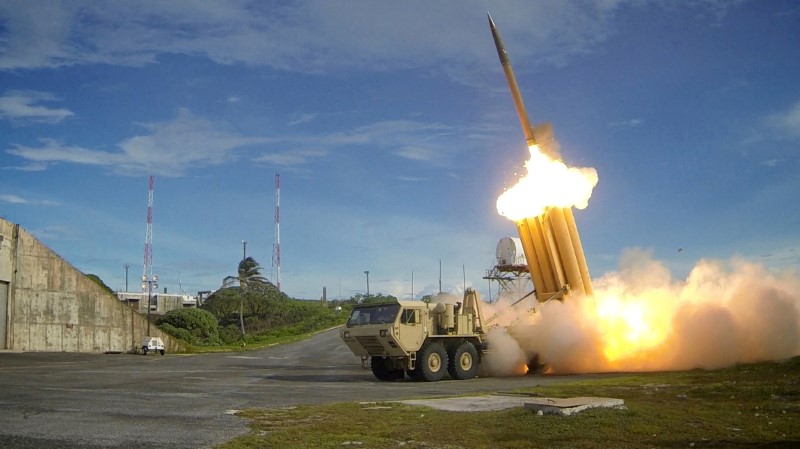Image: A Terminal High Altitude Area Defense (THAAD) interceptor is launched during a successful intercept test, in this undated handout photo provided by the U.S. Department of Defense, Missile Defense Agency. U.S. Department of Defense, Missile Defense Agency/Handout via Reuters/File Photo
By Ju-min Park and Jack Kim
SEOUL (Reuters) – The U.S. military started moving parts of the controversial THAAD anti-missile defence system to a deployment site in South Korea on Wednesday amid high tensions over North Korea’s missile and nuclear programmes.
Washington and Pyongyang have been ratcheting up pressure on each other in recent weeks, with the United States sending a aircraft carrier group and nuclear submarine to the region and North Korea attempting more missile launches in defiance of layers of U.N. sanctions.
North Korea said on Wednesday leader Kim Jong Un had supervised the country’s “largest-ever” live-fire drill to mark the 85th founding anniversary of its military, with more than 300 large-calibre, self-propelled artillery guns demonstrating their fire power at an event on its east coast.
The firing drill came instead of a nuclear test or the launch of a long-range missile as feared amid pressure from the United States and China, its sole major ally which has been irritated by Pyongyang’s weapons development.
The United States and South Korea agreed to deploy THAAD in response to the threat of missile launches by North Korea. However the move has angered China, which says the advanced system will do little to deter the North while destabilising the regional security balance.
South Korea’s defence ministry said some elements of the Terminal High Altitude Area Defence (THAAD) system were moved to the site on what had been a golf course in the county of Seongju in the country’s southern region.
“South Korea and the United States have been working to secure an early operational capability of the THAAD system in response to North Korea’s advancing nuclear and missile threat,” the ministry said in a statement.
The U.S. and South Korean militaries have been reluctant to publicly discuss the progress of the deployment as candidates in a May 9 presidential election debated whether the move should go ahead or be delayed until after the vote.
Television footage showed military trailers carrying large units including what appeared to be launch canisters being driven into the planned THAAD battery site, about 250 kilometres (155 miles) south of Seoul. Images showed local protesters hurling water bottles at the vehicles and police trying to block them.
A U.S. submarine designed to carry 150 Tomahawk cruise missiles entered a South Korean port on Tuesday as the USS Carl Vinson carrier group steamed towards the Korean waters in an effort to deter the North from a sixth nuclear test and more missile launches.
South Korea’s navy has said it plans to hold a joint drill with the U.S. strike group late this month.
TEST OF FIRE POWER
The North’s KCNA news agency said Kim Jong Un supervised the live-fire drill by its artillery units, navy and airforce and involving submarines firing torpedos.
“The brave artillerymen mercilessly and satisfactorily hit the targets and the gunshots were very correct, he said, adding that they showed well the volley of gunfire of our a-match-for-a-hundred artillery force giving merciless punishment to the hostile forces,” KCNA said.
U.S. President Donald Trump has vowed to prevent the North from being able to hit the United States with a nuclear missile and has said all options are on the table. He said North Korea a global threat and “a problem that we have to finally solve” while calling on the U.N. Security Council to impose new sanctions.
U.S. Senator Lindsey Graham said he and fellow Republican John McCain had dinner with Trump on Monday and discussed North Korea. Graham told Fox News he was impressed by Trump’s resolve.
“He’s not going to let this nut-job in North Korea develop a missile with a nuclear weapon on top to hit America,” Graham said, referring to North Korean leader Kim Jong Un.
The United States began moving the first elements of the advanced missile defence system into South Korea in early March after the North test-launched four ballistic missiles.
South Korea accuses China of discriminating against some South Korean companies operating in China because of the THAAD deployment.
Seoul and Washington say the sole purpose of THAAD is to defend against North Korean missiles, but China is concerned the system’s powerful radar can penetrate its territory and undermine its security.
(Editing by Lincoln Feast)
Copyright 2017 Thomson Reuters. Click for Restrictions.


